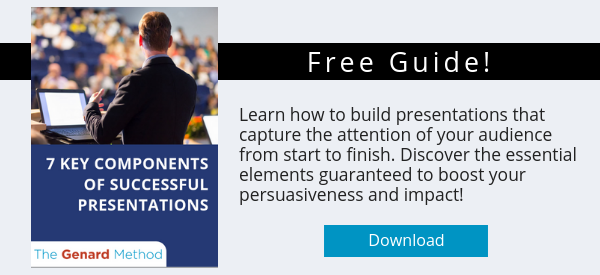
Got what you want to say down pat? Think again! Here's a surprisingly easy yet effective way to make your message clear and powerful.
One of the hallmarks of studying anything for a long period of time is understanding that you still know a lot less about it than you think. This should always be a happy conclusion. It means that you can basically spend a lifetime pursuing something you love.
Public speaking is like that. So, for that matter, is coaching and training people how to do it well.
How do you decide what to include in your speeches to succeed? Get my Free white paper, "The 7 Key Components of Successful Presentations."
For instance, at some point during the last 19 years as a speech coach, I came to a conclusion I couldn't have anticipated. It has to do with strengthening and solidifying one's message. Best of all, it's usually my client who discovers exactly how to do so.
First, Prepare for Your Presentation the Right Way
Chances are, though, you won't travel that road yourself unless you set yourself up for the journey. What I mean by that is, by preparing for your presentation in the right way.
How do most of us prepare? Well, I think the process goes like this: we have some thoughts about a topic, and immediately begin jotting down our ideas. Then we edit and polish our content—and perhaps spend a lot of time on our slide deck—until we think the material is where it needs to be. Then, maybe, we practice out loud (if we have the time).
The result often is that we're flying blind where the audience is concerned. We invested all our energy in perfectionizing our content. In the process, we left out two hugely important factors: our audience's needs and preferences, and our specific purpose in giving the speech.
Best, then, to rearrange the order of things. Your initial effort should always involve an audience analysis. You need to understand your listeners as closely as possible! That may be easy if you'll be speaking to your team at a weekly meeting, or much more involved if the listeners will consist of a group you don't know. From knowing your audience, emerges the purpose for which you'll be speaking to these people. And here's the payoff: knowing exactly what you're trying to achieve helps you bring in precisely the content that will allow you to achieve that purpose. You've now prepared the right way.
Learn more about how to speak for leadership. Download my Free e-book, "High-Impact Speaking: The Leader's Guide to Presenting with Integrity and Influence."

Now Go One Step Beyond That . . . for Greatness!
At this point, it's critically important that you practice your material out loud. You need to hear whether your spoken performance is right for this audience: in terms of language, tone, comprehensibility, and most important: listeners' level of understanding.
And here's where you may surprise yourself. When I'm working with a client and we've videotaped (or these days, screen recorded) a talk, I often ask this question: "What are you really trying to say here?" It's usually easy for the client to respond. But here's the interesting thing: very often, that response will be much clearer, and more in-depth, than what he or she said in the actual presentation. My follow-up question is even easier: "Why don't you say that?"
It's often in this debriefing exercise, you see, that the speaker reveals the true heart of the message. I suspect that may be because they are trying to fashion a commendable presentation, rather than tapping into the raw power of what they're trying to say.
So if you're not debriefing with a speech coach, perform some self-discovery. Practice your talk, record it, and then ask yourself: "What am I really trying to say?" I'd bet that your response is different—in some large or small way—than the actual content of your talk. The next step is obvious: Go back into your content, and make your message clearer and more powerful.
You should follow me on Twitter here.
Gary Genard is an actor, author, and expert in theater-based public speaking training. His company, Boston-based The Genard Method offers in-person and online training to help executives and teams become extraordinary communicators. In 2020 for the seventh consecutive year, Gary has been ranked by Global Gurus as One of The World's Top 30 Communication Professionals. He is the author of How to Give a Speech. His second book, Fearless Speaking, was recently named as "One of the 100 Best Confidence Books of All Time." Contact Gary here.



